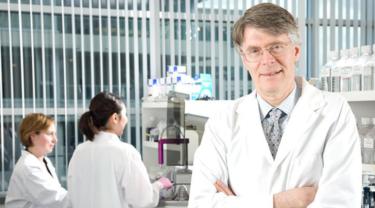As the founding director of the Terry Fox Laboratory for hematology and oncology research, Allen Eaves knew he needed certain tools to do his work. Knowing there would be like-minded researchers all over the world in search of similar tools, he commercialized them in the form of a company called STEMCELL Technologies.
Thanks to Dr. Eaves’ international reputation, the first product, called MethoCult, immediately started selling globally. More than 2,000 products — yes, 2,000 — have since been launched around the world, says Andrew Booth, CFO of STEMCELL Technologies. Today, the company has approximately $150 million in revenue and more than 800 employees.
“We provide tools to health sciences researchers,” Booth explained. “We make kits that are used to handle cells; to grow them or isolate them. For example, if researchers have a biological sample and they are looking for a specific type of cell, they can use our tools to isolate the cells they want or eliminate the ones they don’t. We like to say that STEMCELL makes the picks and shovels of the stem cell gold rush.”
STEMCELL products typically come in the form of bottles of media for the expansion of cells — to grow and multiply them — and as kits or vials of reagents for separating or enriching cells.
“Those media and reagents are our two core competencies and that’s why people come to us,” Booth said. “We’re quite good at developing products for very difficult-to-handle cell types. From these core competencies, we have expanded the product lines to include instruments, education and training, contract services and other support products.”
Today, the products sell to scientists who, according to Booth, are continuing the great work pioneered by Canadians James Till and Ernest McCulloch, who discovered the hematopoietic, or blood, stem cell in the early 1960s.
“Till and McCulloch went on to train the next generation of scientists, from which Dr. Allen Eaves and his wife, Dr. Connie Eaves benefited,” he said. “They and others went on to found world-leading labs and train the next generation, and so on. Those people are now our customers.”
Today, STEMCELL’s customers include hematologists, cell biologists, immunologists, neural scientists and people at academic and industrial research labs trying to understand and prevent disease. The products are only sold within a research setting, however.
“We don’t provide therapeutic products. As a result, the revenues and the business are much more stable than they would be if we were a pharma company or medical-device manufacturer.”
The company’s customers include most leading academic institutions around the world. Less than five per cent of its revenue comes from Canada and the rest from more than 70 countries, some 15 of which are serviced by STEMCELL’s direct sales force. Approximately 50 per cent of revenues come from the U.S., 25 per cent from Europe and the rest from the Asia-Pacific region, including China where STEMCELL recently opened a trading company from which it can supply its distributors on shore in that country.
Those at the helm of this veteran exporting company have learned much over the 20 years they’ve been selling outside Canada. STEMCELL’s exporting journey began by selling into the U.S. and through distributors in Asia and Europe. Once it had the resources to build direct-sales channels in foreign markets, it did so. The company’s 10-year plan involves expanding its direct-sales force one country at a time.
Booth says every country has its own rules and regulations and aspiring exporters should be aware of that. Understanding how a sales cycle works, how funding may be approved and payment applied are important, as is being clear on local product registration and custom clearance and duties requirements. Companies must also build and maintain a price list in the local currency and be clear on local regulations relating to taxes.
“Because of STEMCELL’s model to build a direct sales force in each region, a big challenge has also been setting up the infrastructure to be an employer in each one of these countries,” he said. “The local regulations, corporate structures, tax and payroll systems are typically a big challenge and different in each country.”
“I believe that the way we have overcome these challenges is by getting good local help,” he said. “This has come either through advisers or, more often, by hiring smart local people to help us learn the local ways. As Vancouver is also a very multi-cultural city, often we have a Canadian employee from the country or region to which we are planning to expand or export to who can help us translate our company culture into the local dialect. We have many examples of this: China, Brazil, South Korea and India come immediately to mind.”
Get more exporting insights from STEMCELL Technologies’ Andrew Booth here.





